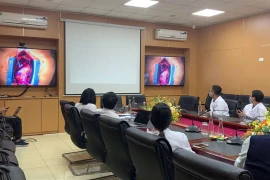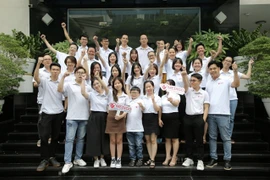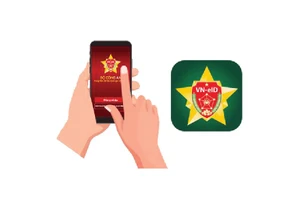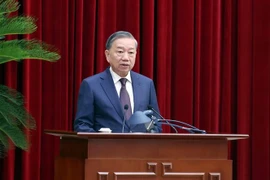Hanoi (VNS/VNA) - In April 2020, during the peak of the COVID-19 pandemic, Hanoi Medical University Hospital launched its first trial telehealth sessions, connecting doctors in the capital with patients in Lao Cai, Ha Tinh and Thanh Hoa provinces.
Since then, the telehealth model has expanded rapidly, now connecting hundreds of health stations across the country with thousands of patients — both Vietnamese and foreign nationals.
Supported by international partners, the Ministry of Health continues to promote the model as a strategic solution to improving healthcare accessibility.
Assisted by the United Nations Development Programme (UNDP), since 2020 the ministry has deployed the 'Doctor for Everyone' telehealth software in eight provinces: Ha Giang, Bac Kan, Lang Son, Thua Thien-Hue, Quang Ngai, Binh Dinh, Dak Lak and Ca Mau.
The ministry is currently working with the Korea Foundation for International Healthcare (KOFIH) and UNDP to implement the project 'Telehealth to Improve Access to Healthcare Services for Disadvantaged Groups in Vietnam'.
The project targets 10 remote and mountainous provinces still facing barriers in accessing healthcare.
Over the past six months, 150 communal health stations in provinces including Ha Giang, Bac Kan, Lang Son, Lao Cai, Lai Chau, Yen Bai, Tay Ninh, Hau Giang, Ben Tre and Ca Mau have been equipped with information technology systems. In addition, 117 key provincial healthcare workers have received training, with thousands more expected to follow.
Deputy Minister of Health Tran Van Thuan said telehealth reflects the modernisation of healthcare in Vietnam, helping expand equitable access to medical services, especially in underprivileged areas.
“Telehealth is a practical, humanitarian and meaningful model of international cooperation,” he said.
“It contributes to realising the goal of leaving no one behind in community healthcare.”
He said telehealth is a strategic breakthrough for the healthcare sector as Vietnam builds a modern, efficient and equitable national health system.
Associate Professor Nguyen Lan Hieu, director of Hanoi Medical University Hospital, said Vietnam is well-positioned to advance telehealth, given the Government’s commitment to digital transformation and a high internet penetration rate, with approximately 73.2% of the population — nearly 75 million people — online.
“With early adoption of telehealth at Hanoi Medical University Hospital, we believe combining traditional medical care with digital technology will enhance treatment efficiency and further the hospital’s reputation,” he said at a recent Vietnam–RoK telehealth workshop.
“Digital transformation cannot be applied uniformly. It must be customised to suit each institution or locality. This calls for close coordination not only among domestic institutions but also with international partners,” he said.
The hospital has been a pioneer in adopting technology in healthcare management, including electronic medical records, telemedicine, telepathology, tele-intensive care units and tele-education. It has conducted over 3,500 teleconsultations and 1,200 health check-ups since 2020, with participation from about 165 doctors.
Hieu noted that telehealth has significantly reduced travel time and patient waiting times while improving access to specialised services. Patients can join consultations via private video calls or dedicated mobile apps.
However, he acknowledged two major challenges: the cost and limited efficiency.
“Few patients register for telehealth because they have not yet seen its full benefits. Telehealth must demonstrate greater help than AI tools like ChatGPT or common messaging platforms such as Viber or Zalo,” he said.
To enhance adoption, he suggested integrating patient-tracking devices for at-home consultations.
His hospital aims to trial the devices with over 1,000 patients to evaluate satisfaction.
“In the long term, Vietnam should aim to produce its own medical devices to better serve domestic needs,” Hieu said.
Health experts agree that building a robust database of online health records is essential for the growth of telehealth.
Director General of the Department of Medical Service Administration Ha Anh Duc said the department is working to complete around 40 million electronic medical records this year and to establish health profiles for all citizens starting from birth. These profiles will be updated with regular health check-up results.
Dr Nguyen Van Linh from the Department of Health of Yen Bai province, one of the first localities to adopt telehealth under the KOFIH partnership, proposed creating a smart healthcare ecosystem with three core pillars: electronic medical records, AI-assisted diagnosis and telehealth services.
“These elements should be integrated into the VNeID app for convenient access for citizens,” he said.
Linh added that in many countries, telehealth is most effective during patients’ follow-up visits. Once patients have a digital medical history, telehealth becomes far more efficient.
With the national deadline for applying electronic medical records set for September, Yen Bai plans to begin widespread implementation in July, he said./.

See more
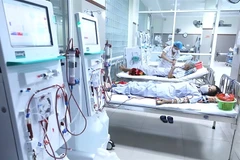
Vietnam sees alarming surge in diabetes cases, over half undiagnosed
An estimated 7 million Vietnamese are currently living with diabetes, but about 50% remain undiagnosed, a dangerous gap that is fuelling serious, preventable complications and increasing the burden on the healthcare system.
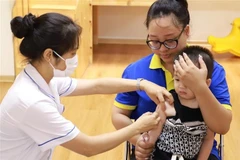
WHO, UNICEF commend Vietnam’s progress in childhood immunisation
In 2024, Vietnam achieved 99% coverage for the first dose of the diphtheria, tetanus and pertussis vaccine, up from 80% in 2023. Immunisation coverage in the country has not only rebounded to the high levels seen before the COVID-19 pandemic but has now surpassed the rates recorded in 2019.
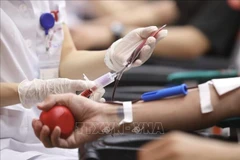
Hanoi blood donation campaign sets to collect 4,000 units of blood
The organisers hope the drive will help boost emergency and treatment blood supplies during summer—a time when donations often decline sharply.
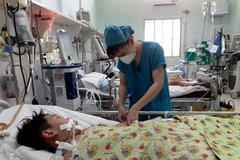
HCM City reports six dengue deaths, raises outbreak alert
Health authorities in HCM City have issued an urgent alert after six people died from dengue fever, amid a spike in infections driven by the onset of the rainy season.
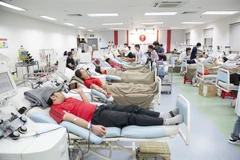
Health sector calls on people to donate blood
During the peak months of July and August 2025, the National Institute of Haematology and Blood Transfusion (NIHBT) needs at least 90,000 units of blood to supply 180 hospitals in the northern region. However, despite continuous efforts, the reserve blood is still short of 30,000 units.
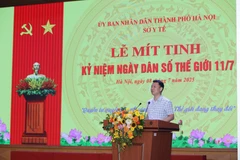
Hanoi celebrates World Population Day
The Hanoi ceremony highlighted efforts to ensure all citizens, especially women and youth, can access accurate information and healthcare services to make informed reproductive choices.
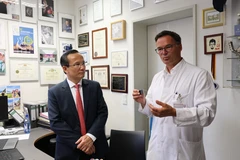
Vietnam, Germany forge cardiovascular partnership
Currently, cardiovascular specialists from the 108 Military Central Hospital are working alongside a team of Prof.Dr. Jan D. Schmitto, Deputy Director of MHH’s Department of Cardiac, Thoracic, Transplantation and Vascular Surgery on clinical trials for MCS devices, implanted in heart failure patients either as a bridge to transplantation or as permanent treatment.
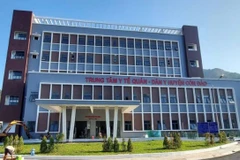
HCM City seeks to build general hospital on Con Dao Island
The centre not only serves residents living on the island, but also receives tens of thousands of visitors every year, according to Assoc Prof Dr Tang Chi Thuong, Director of the HCM CIty Department of Health.
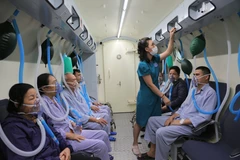
Vietnam – attractive destination for medical tourism
Not only does Vietnam attract international tourists with its landscapes, culture, and cuisine, but it is also gradually becoming a reliable destination for medical treatment, offering high-quality services at reasonable costs.
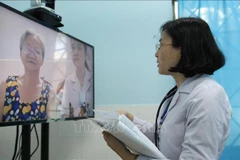
Vietnam, RoK strengthen cooperation in telemedicine
During the COVID-19 pandemic in 2020, the Ministry of Health swiftly launched a telemedicine programme, connecting more than 1,000 medical establishments nationwide. The model, which remains in operation, has benefited tens of thousands of patients, including foreign nationals.

HCM City doctors revive Cambodian infected with “flesh-eating” bacteria
After more than three weeks of intensive treatment, the patient's pneumonia improved, breathing stabilised, sedation was reduced, and the breathing tube was removed. He is now conscious, able to eat orally, and in recovery.
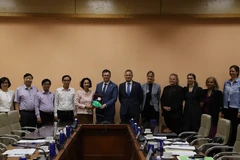
Vietnam, Denmark launch phase 3 of strategic health sector partnership
Vietnam is currently reshaping its grassroots healthcare system to better serve a rapidly ageing population, address changing disease burdens, and meet rising public expectations fuelled by economic growth.

Vietnam joins 110 countries in taxing to raise unhealthy products’ prices
The press awards on non-communicable disease prevention, launched on April 28, received enthusiastic participation from journalists across various media outlets, with over 120 entries submitted.
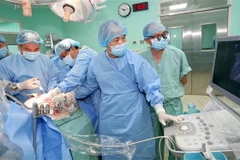
Hue Central Hospital successfully performs four simultaneous organ transplants
Despite storm-related disruptions and flight delays, the organs were successfully transported via a combination of air and ground travel. All patients are currently stable and recovering well.
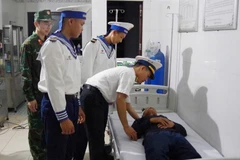
Injured fisherman in Truong Sa receives timely medical operation
The patient, Tieu Viet But, born in 1970 and residing in Binh Tri commune, Binh Son district, the central province of Quang Ngai, was working aboard fishing vessel Qng – 95657TS when the incident occurred at 7:00 am.
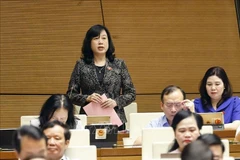
No counterfeit drugs in hospitals: Health Minister
All drugs entering hospitals must have a clear origin, so counterfeit drugs are only in the market, not in hospital, affirmed Minister of Health Dao Hong Lan.

Brain-dead man's organs save seven lives in Vietnam
Thong Nhat Hospital in Ho Chi Minh City announced on June 16 that the transplants were successfully performed using the man’s donated organs.

Vietnamese hospital seeks stronger ties with British partners
A surgical training centre based on the RCS model will be set up at 108 Military Central Hospital (Hospital 108) in Hanoi.

Experts call for joint efforts and integrated disease prevention to end dengue deaths
Health experts called for collective disease prevention and integrated solutions to achieve zero dengue deaths in the country at an online talk show on June 14.

PM seeks stronger medical ties with Sweden’s Karolinska Institutet
The PM called for closer, broader, and more effective cooperation with Vietnamese partners, guided by the principles of mutual benefit, joint efforts, shared outcomes, and common development, including promoting stronger public-private partnerships and collaboration with businesses.
